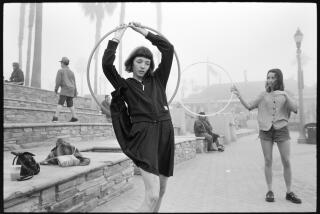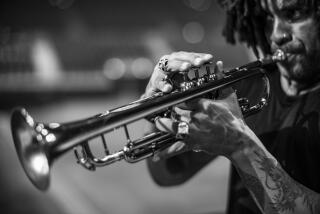A Kite Takes His Camera to New Perspectives
- Share via
Ever since cameras became popular in the late 19th century, photographers have been fastening them to dogs, horses, birds, bikes, skydivers, model rockets, trains, planes and automobiles--always in search of an original angle or attention-grabbing shot.
A few years ago, a network television crew even tried attaching a tiny camera to the head of a brown tree snake, a rapacious reptile that was single-handedly wiping out the bird population of Guam.
Much closer to home, Cris Benton of Berkeley practices kite aerial photography. As the name of his hobby implies, Benton gets his thrills--and plenty of striking photos--by dangling his camera from kites.
The unusual hobby is both a sport and an art, with only a few hundred practitioners around the world. Benton is a relative newcomer, but his kite photography Web site has become a sort of clearinghouse for anything having to do with kites and cameras.
Benton is willing to attach a pricey piece of equipment to something that could come crashing down to earth at any moment to achieve a unique perspective on commonplace subjects.
His photos of natural and urban landscapes offer a striking contrast to images taken from terrestrial vantage points along roads or hiking trails. His work is also quite different from pictures shot from planes or helicopters, which fly at much higher elevations. A kite, in Benton’s view, flies just high enough off the ground to offer a fresh view of the familiar.
He makes his point with an overhead image of surprisingly disorderly rows of a San Mateo pumpkin patch, with the pleasing symmetry of three giant oil tanks in Point Richmond taken from directly above and with a sweeping view of Limantour Beach at Point Reyes National Seashore, taken at sunset.
“Most of the really productive stuff I shoot is below 250 feet,” Benton said. “It’s not that high off the ground, but it’s in the space that we obviously can’t occupy. Unlike putting a camera on a radio-controlled plane that’s flying around, the kite kind of hovers and I can walk it right up to, say, a building.”
Benton started in 1995, kiting his camera over rural scenes. He favored sparsely populated areas, he said, because “you don’t have to worry about dropping a camera on someone’s head.”
In time, his curiosity about urban subjects overcame his misgivings and he began documenting the geography of cities and buildings from the air.
He found that he could easily spend a day at Oakland’s port, for example, composing shots of railroad tracks curving past storage containers.
He even took his kite and camera rig to Europe on a recent trip and took overhead shots of small French villages and vineyards. At the Burning Man festival in Nevada last year, he lofted his camera above people riding their bikes, and got a series of candid and unusual shots of people grinning and waving upward.
Benton’s preoccupation with unusual angles grows out of professional interests. He is the chairman of UC Berkeley’s architecture department. Even though he calls himself an amateur photographer, Benton has sold a few images to publishers who have come across his expansive online portfolio at www.arch.ced.Berkeley.edu/kap.
The popularity of kite photography is closely tied to the Internet. Because there are no kite photo kits in stores, the Web allows enthusiasts from all over the globe to share photos and tips on how to use the wind to lift a camera skyward.
Benton’s camera is mounted on a homemade “cradle” built from a variety of materials, including the hard drive of a computer. After the kite is safely airborne, a pulley system lifts the cradle up the kite string. A remote-control handset is used to rotate the camera in various directions and trigger the shutter.
Many kite photographers actually mount two airborne cameras. They attach a video camera to a still camera, allowing them to preview what they are shooting.
That’s not Benton’s style. He said he does a lot of “pondering.” Part of the thrill for him is waiting to see what images his camera has captured at the end of the day. “It’s like fishing,” he said.
Of course, fishing poles don’t have a nasty habit of getting caught in trees or suddenly plummeting toward San Francisco Bay when the breezes die. It’s no big deal when it happens to a cheap paper kite, but rather a painful setback when a $500 digital camera is along for the ride.
“I’ve been doing this since 1995 and haven’t lost a camera yet,” Benton said. “I’m due.”


